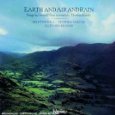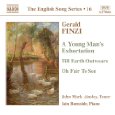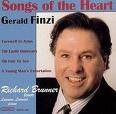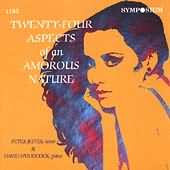The Market-Girl
- Musical Analysis Section
- Audio Recordings Section
- Unpublished Analysis Excerpts
- Gerhardus Daniël Van der Watt - The Songs of Gerald Finzi (1901-1956) To Poems by Thomas Hardy
- Mark Carlisle - Gerald Finzi: A performance Analysis of A Young Man's Exhortation and Till Earth Outwears, Two Works for High Voice and
- Leslie Alan Denning - A Discussion and Analysis of Songs for the Tenor Voice Composed by Gerald Finzi with Texts by Thomas Hardy
Poet: Thomas Hardy
Date of poem: 1902 (Purdy, 143-4)
Publications date: "First printed as 'The Market Girl (Country Song)' in The Venture, An Annual of Art and Literature, edited by Laurence Housman and W. Somerset Maugham (London, 1903), p. 10. (Purdy, 144)
Publisher: Macmillan Publishing Company
Collection: The Market-Girl is found in a group of seven poems that Hardy entitled:
At Casterbridge Fair. He included At Casterbridge Fair in a group of seventeen poems in: Time's Laughingstocks under the heading: "A Set of Country Songs."
History of Poem: "The Market-Girl first appeared in an annual called The Venture. Laurence Housman, in a letter of July 18, 1903, asked Hardy for a poem for “a literary and artistic annual . . . which I am editing for publication next Christmas.” Hardy replied on July 21 that he “might find a small song or poem of some sort of two or three stanzas.”(In the Dorset County Museum) Housman wrote again on September 1 to remind Hardy, who on September 2 sent “The Market Girl (Country Song).” (Bailey, 225-6)
“The Market-Girl” has been set to music by Arnold Bax (London: Murdock, Murdock, & Co., 1922), and Alfred Hale in At Casterbridge Fair (in manuscript in the Colby College Library).”
(Bailey, 226)
Poem:
(IV. The Market-Girl) |
||
|---|---|---|
| 1 | NOBODY took any notice of her as she stood on the causeykerb, | a |
| 2 | All eager to sell her honey and apples and bunches of garden herb; | a |
| 3 | And if she had offered to give her wares and herself with them too that day, | b |
| 4 | I doubt if a soul would have cared to take a bargain so choice away. | b |
| 5 | But chancing to trace her sunburnt grace that morning as I passed nigh, | c |
| 6 | I went and I said ‘Poor maidy dear! – and will none of the people buy?’ | c |
| 7 | And so it began; and soon we knew what the end of it all must be, | d |
8 |
And I found that though no others had bid, a prize had been won by me. | d |
(Hardy, 240) |
||
Content/Meaning of the Poem:
Stanza 1: Nobody paid any attention to the market-girl as she stood on the curb, she was eager to sell her produce and honey; I doubt if anyone would have taken her up on a wonderful opportunity even if she had offered to give her products and herself away on that day,.
Stanza 2: But taking a chance, I attempted to speak to the girl, I asked her about her sales for the morning, knowing full well that she had not had any luck, and thus the ice was broken; and before long we realized what we had was very special. I found that even though no one else had approached her that morning, there loss was now my gain.
For additional comments about the meaning of the text please refer to: Content - Van der Watt.
Speaker: Possibly Thomas Hardy, himself. For additional commentary please refer to: Speaker - Van der Watt.
Setting: “The location is Dorchester, perhaps on South Street near High West, where farmers still bring produce for sale at the “causey kerb,” beside a street paved with cobblestones in Hardy’s time.”
(Bailey, 226)
Purpose: To remind one to take time to smell the roses as one goes through life.
Idea or theme: Life is fleeting so one must attempt to take advantage of all joy that might comes their way.
Style: The poem is written in a "narrative and pastoral love lyric style" according to Gerhardus Daniël Van der Watt. (Van der Watt, 376) To view Dr. Van der Watt's comments please refer to: Style - Van der Watt.
Form: The form of the poem according to Gerhardus Daniël Van der Watt, "consists of two unusually long-lined quatrains with a paired rhyme scheme: aabb ccdd." Dr. Van der Watt goes on to say, "The textual metre is mainly dactylic, with a number of trochaic and iambic interpolations." (Van der Watt, 376)
Synthesis: One of the first questions that comes to mind with this poem is to whether or not it is autobiographical. It seems highly plausible that the poem could be a romantic tryst that Hardy had with a girl he met, he was particularly fond of travelling about the countryside observing nature and he did have a reputation for several affairs according to his biographers, Millgate and Seymour-Smith. Gerhardus Daniël Van der Watt suggests in his dissertation, that: "The poem was almost certainly written tongue-in-cheek and with characteristic irony on Hardy's part. It is a well-known fact that Hardy had several affairs or rather attempted affairs before, during and after his two marriages (Tryphena Sparks, Eliza Nichols, Emma Gifford (first wife), Rosamund Thompson, Florence Henniker, Florence Dugdale (second wife), Gertrude Bugler and many more!). Martin Seymour-Smith writes in his biography, Hardy, about the 1890s:" (Van der Watt, 376) Whether the poem is autobiographical or not is not really important even though it may be titillating to ponder, what seems of greater importance is the moral of the poem and it can be summed-up in an old adage, "don't judge a book by its cover." One final observation about the poem is its line length: It looks quite different than most of Hardy's poems simply because of its longer lines. Hardy must have realized when he was writing the poem it had a good story line and in order to preserve the narrative nature of story he kept the lines longer, this in turn had the effect of putting less emphasis on a rhyming scheme as well as cadence.
✦✼✦✼✦✼✦✼✦✼✦✼✦✼✦✼✦✼✦✼✦✼✦✼✦✼✦✼✦✼✦✼✦✼✦
Time's Laughingstocks and Other Verses
- Collection of 94 poems written by Thomas Hardy.
- Published in December of 1909 by Macmillan and Company.
- Poems were written over a period of 40 years.
F. B. Pinion categorizes the poems as generally somber in tone with some having a more light-hearted nature. (Pinion, 64)
Edmund Gosse wrote on Dec. 7, 1909, "how poignantly sad! What makes you take such a hopelessly gloomy view of existence?" (Pinion, 64)
"A reviewer for the Daily News complained that, throughout the volume, 'the outlook [is] that of disillusion and despair." (Wright, 313)
Hardy responded to the reviewer by saying more than half do not fit the description. (Wright, 313)
Gerald Finzi set the following poems within this collection:
- 1967 [titled by Finzi as: In five-score summers!] (I Said To Love)
- Former Beauties (A Young Man's Exhortation)
- He Abjures Love (Before and After Summer)
- In The Mind's Eye (Before and After Summer)
- I Say, 'I'll Seek Her' (Oh Fair To See)
- Let Me Enjoy (Till Earth Outwears)
- The Market Girl (Till Earth Outwears)
- The Sigh (A Young Man's Exhortation)
Helpful Links:
✦✼✦✼✦✼✦✼✦✼✦✼✦✼✦✼✦✼✦✼✦✼✦✼✦✼✦✼✦✼✦✼✦✼✦
At Casterbridge Fair
- A seven part-poem written by Thomas Hardy and dated 1902.
- At Casterbridge Fair was published in the collection of poems entitled Times Laughingstocks in 1909. (Wright, 14)
- Hardy it seems enjoyed attending "fairs" and from these outings he drew inspiration for The Mayor of Casterbridge and more specifically At Casterbridge Fair. The fairs most likely to have given Hardy his inspiration were originally held on Feb. 2nd each year and were called "Candlemas." Later the date was moved to Feb. 14th and renamed "St. Valentine's Fair."(Wright, 14)
- The occasion of the fair was primarily for the hiring of agricultural workers. The workers hired would then assume their duties on "Lady Day" or the Feast of the Annunciation, April 6th. (Wright, 14)
- The Mayor of Casterbridge is a book found in Hardy's Wessex novels.
- Casterbridge is a fictional town based on the real life town of Dorchester.
- Dorchester is located in Dorset.
"The seven sections are vignettes of scenes at the fair, depicting the heartbreak, painful memories, and hopes (both futile and realized) of various people attending the festivities."(Wright, 14)
Part II: Former Beauties was set by Gerald Finzi in a set of songs entitled A Young Man's Exhortation. The text expresses the feelings of one man having seen women middle-aged in a location that he remembered them as being young. He asks the question, are these the same girls we once danced with near the river, Frome and "Budmouth shore."
- Hardy uses the river "Froom" but it is clear he is speaking of the river Frome.
- "Budmouth" is Hardy's fictional name for a town that is the real life boroughs of "Melcombe Regis and Weymouth."(Wright, 29)
Part IV: The Market-Girl was also set by Gerald Finzi. The song can be found in Finzi's song set entitled: Till Earth Outwears. The speaker in the text is a man who observes a young girl attempting to sell honey, apples, and herbs. The man at first feels sorry for the young lady because there are no buyers but later is attracted to the young girl when he approaches her and engages in conversation. He discovers her true beauty and though no others had taken notice of her he had found a gem.
✦✼✦✼✦✼✦✼✦✼✦✼✦✼✦✼✦✼✦✼✦✼✦✼✦✼✦✼✦✼✦✼✦✼✦
Musical Analysis
Composition date: 1927 (Banfield, 144) Revised 1940
Publication date: © Copyright © 1958 by Boosey & Co. Ltd.
Publisher: Boosey & Hawkes Distributed by Hal Leonard Corporation
Tonality: Finzi begins the piano prelude with a minor third seeming to reflect G minor and then in the fourth measure he includes an F-sharp which is the leading tone for G but at the same time he has a pedal tone B-flat creating a augmented fifth or enharmonic, minor sixth which totally obscures the possibility of a dominant chord (see example below).
Tonal ambiguity in opening prelude, measures 1-5. (Finzi, 92)

At times D minor seems plausible given the key signature and also in measure thirteen a neapolitan chord is written on the lowered second scale degree of E-flat but what follows doesn't support D minor (see example below).
Tonal ambiguity and Neapolitan chord in measures 13-5. (Finzi, 92)
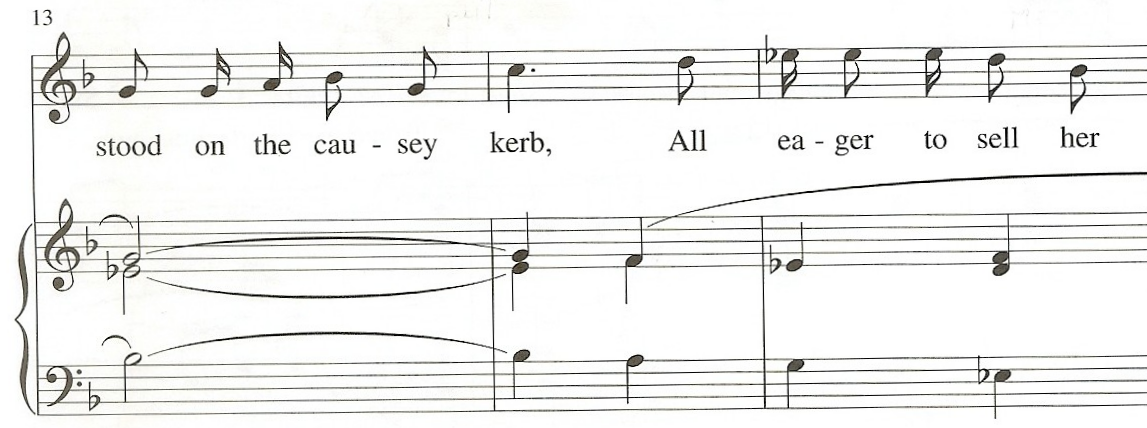
What is also present in the first twenty-two measures is a bass line that frequently moves in a descending stepwise manner leading one to conclude Finzi is utilizing a ground bass (see examples below).
Bass line moving in descending stepwise motion in measures 8-14. (Finzi, 92)


Bass line moving in descending stepwise motion in measures 17-22. (Finzi, 92-3)


The song especially at the beginning resembles a recitative more so than a typical Finzi song but by measure twenty-two the piano accompaniment becomes more active and the aural impression of the tonality becomes more stabilized. Perhaps this can be explained by the loss of stark block chords being replaced by a more quickly moving harmonic scheme. The tonal nature never truly stabilizes in the song but with the inclusion of rhythmic motives and more activity in the piano accompaniment the song becomes more positive and less tension seems present in the harmonic landscape. In the final two measures of the song Finzi does write a very weak dominant seventh chord (C, E, G, B-flat) in third inversion followed by a tonic chord (F, A, C) in first inversion. It looks as if he is going to solidify F major but instead of remaining on the tonic chord Finzi moves to the IV chord (B-flat, D, F) and next to the ii chord (G, B-flat, D) before landing firmly on a root position F major chord (see example below).
Chord progression in measures 46-7. (Finzi, 94)
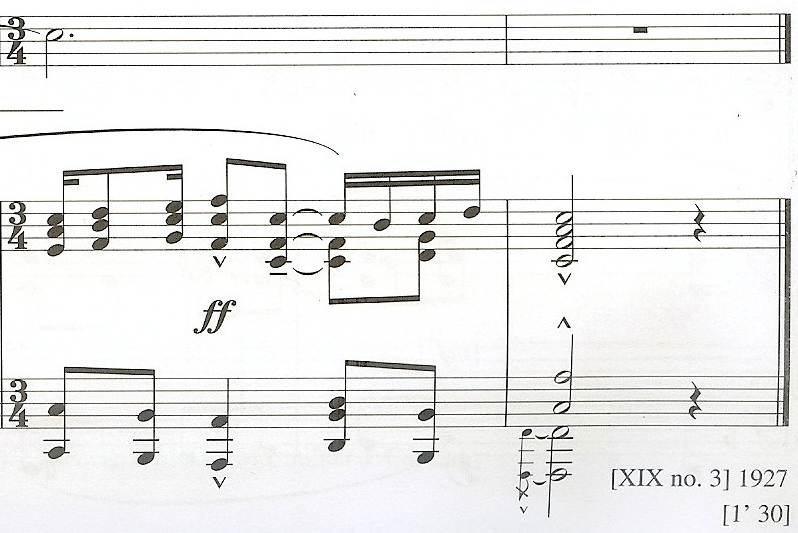
This is an unusual chord progression and definitely unorthodox in more traditional harmony but this is not what was important to Finzi. His pursuit was not couched on whether or not the listener felt a clear tonal center or for that matter, if he ends a song in a different key than he began, instead his goal, was always to support the text. This is where his inspiration welled from. His practice of writing fragments and putting them away is clear evidence the words were the most important and music second. The piano accompaniment was used either directly in support of the text or sometimes took on a more abstract approach when a musical germ or fragment surfaced from within the text.
An interesting observation about the song, even though the tonality seems cloudy and ambiguous, Finzi is able to achieve this with very little use of chromaticism. Gerhardus Daniël Van der Watt suggests the use of pitches outside the parameter of the key signature is simply explained as insignificant, a temporary tonality, or in support of the text. Dr. Van der Watt writes: "There are some chromatic alterations though it is not always clear what is meant to be chromatic and what is part of a swiftly changing key. The G flat and D flat in the g minor context in bar 9 is certainly intentional chromaticism. At the final chord of the prelude, a sense of expectation is created as if the market girl expects someone to buy, yet it does not happen. The occurrence of an A flat is mostly explainable in E flat major and therefore does not have a true chromatic function." (Van der Watt, 381)
Mark Carlisle in his comments about the tonal ambiguity of the piece records the following: "The overall harmonic structure of the piece is also of a very flexible nature, as rarely is any single key defined well enough to be recognized as the predominate key of the song. This harmonic instability corresponds well to the emotional uncertainty of the poet as he attempts to comfort the young market-girl." (Carlisle, 48) To view Dr. Carlisle's comments in total about the tonality of the song please refer to: Original Key - Carlisle. Gerhardus Daniël Van der Watt suggests that because there are nineteen measures of F major that it should be considered "the most prominent key and consequently it carries the most prevailing atmosphere." (Van der Watt, 380) Dr. Van der Watt has also prepared a table where he outlines the tonal scheme, he includes suggestions as to why tonal shifts occur. To view his comments and the table outlining modulations please refer to: Tonality - Van der Watt.
Transposition: The song is available a minor third lower than the original key. The transposed version may be found in the Medium/Low Voice edition by Boosey & Hawkes entitled: Gerald Finzi Collected Songs 54 Songs Including 8 Cycles or Sets.
Duration: Approximately one minute and thirty-five seconds.
Meter: The song is written in 2/4 except for the last two measures where Finzi uses 3/4. Gerhardus Daniël Van der Watt explains the use of 3/4 at the conclusion of the song as "prolonging the expression of ecstasy." (Van der Watt, 377) To view Dr. Van der Watt's comments about the meter please refer to: Metre - Van der Watt.
Tempo: The opening indication is for Tempo commodo with the quarter note equalling c. 72. When the vocal line enters in measure eleven, above it is indicated Quasi recitative. The next indication, Poco animato piu cantando with the quarter note equalling c. 76 is in measure twenty-two. This indication coincides with the piano accompaniment becoming more active. Pochissimo ritardando is indicated in measure twenty-five over the text "bargain so choice away." A tempo is indicated at the beginning of measure twenty-seven. There is a ritenuto indication above the text "went and I said" in measure thirty-one continuing on through measure thirty-six. A tempo is once again indicated in measure thirty-seven. A poco allargando is indicated over the climax of the song in measure forty with the text "All must be." A tempo follows in measure forty-two and there are no further deviations. For additional comments about the tempi please refer to: Speed - Van der Watt.
Form: The song is through composed. There is a short rhythmic and melodic motif first found in measure three and then repeating throughout the song in both the vocal line as well as the accompaniment that offers some unity to the structure (see example below).
Rhythmic and melodic motif in measure 3. (Finzi, 92)
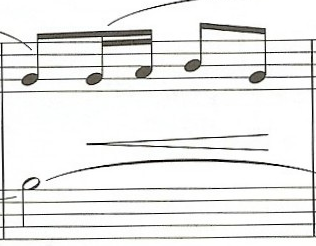
The two stanzas are not discernible in respect to the form of the song. The first indication of a new section is in measure twenty-two where the piano accompaniment becomes more active. Measure twenty-two is also the third time the short rhythmic and melodic motif is heard in the piano (see example below).
Accompaniment is more active at the beginning of measure 22. (Finzi, 93)
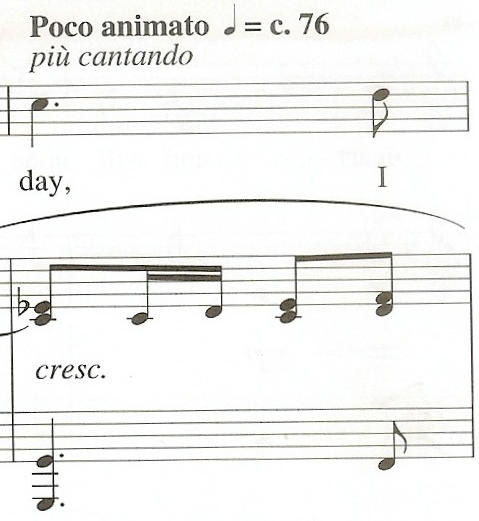
The second stanza of text begins with a pick-up to measure twenty-seven (see example below). The only discernible evidence that something new is beginning is the tempo indication of a tempo, which is following a very small ritardando, otherwise it would probably go unnoticed.
Second stanza of text in measures 26-7. (Finzi, 93)
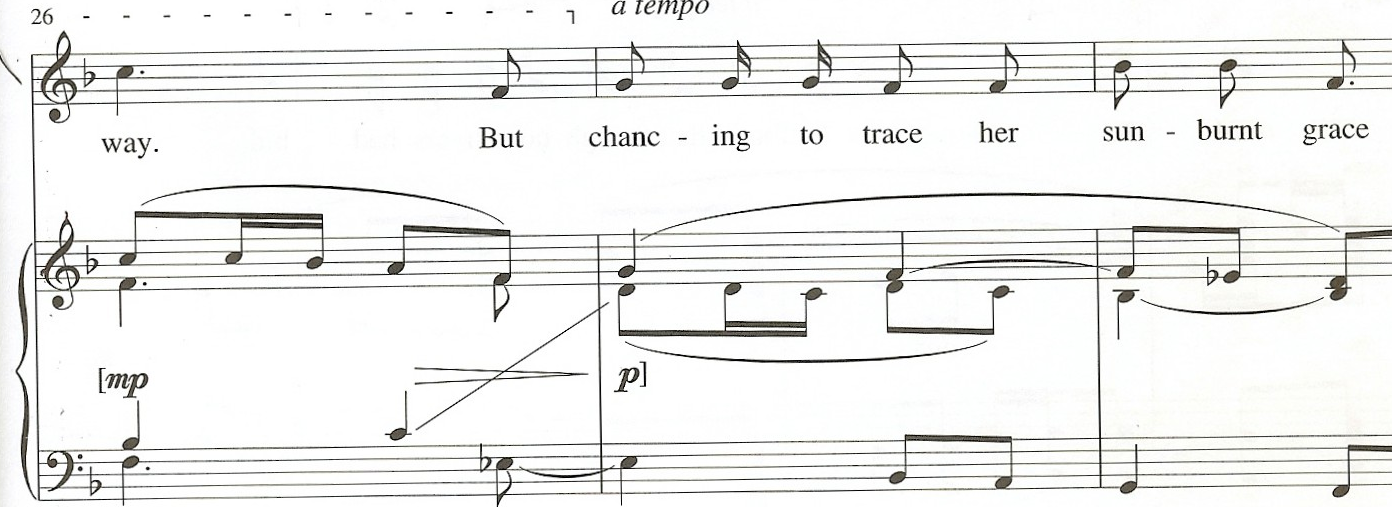
A stronger indication of a new section corresponds with the third line of text in the second stanza which begins with a pick-up to measure thirty-seven and coincidentally another a tempo indication is here as well. In measure thirty-five the motivic theme is once again heard but instead of dovetailing the motif into the next line of poetry Finzi allows the question mark at the end of the text "and will none of the people buy?" to linger for a moment (see example below).
The end of line six of the poem, measures 33-6. (Finzi, 94)

When the text re-enters with the a tempo indication at measure thirty-seven the rhythmic activity increases in the accompaniment as the song speeds toward the climax in measure forty. The increased activity has the effect of a stretta even though there are only eleven measures remaining (see example below).
Stretta in measures 37-47. (Finzi, 94)

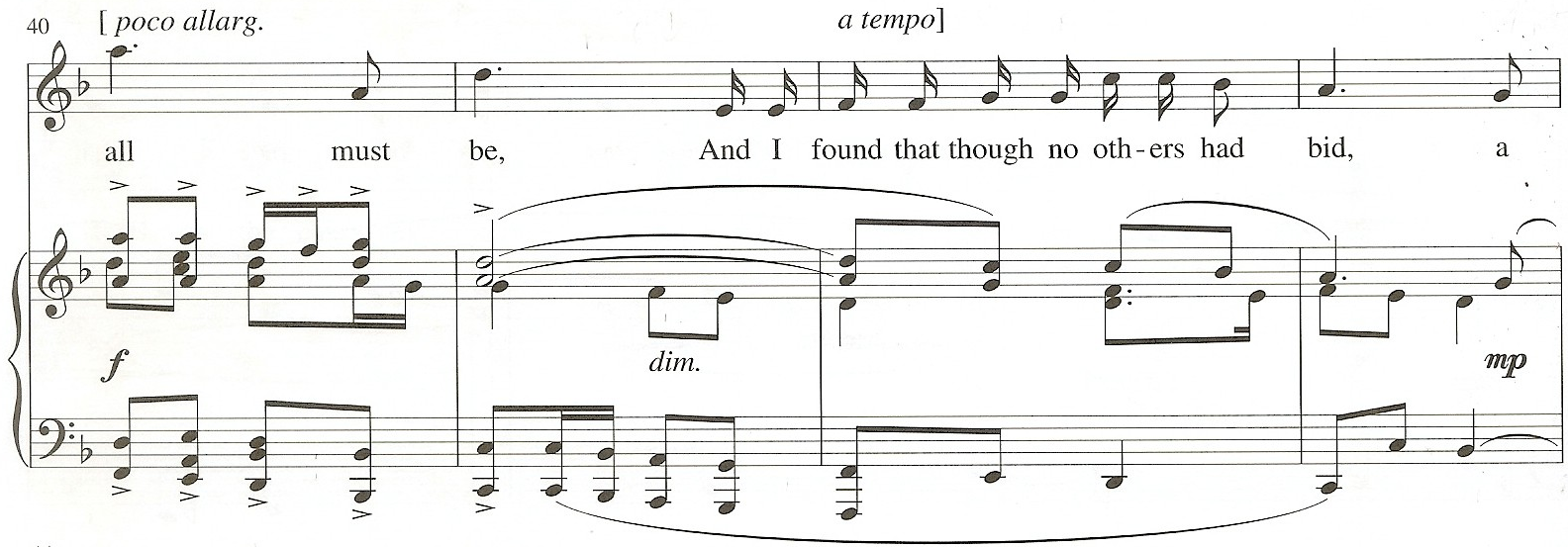
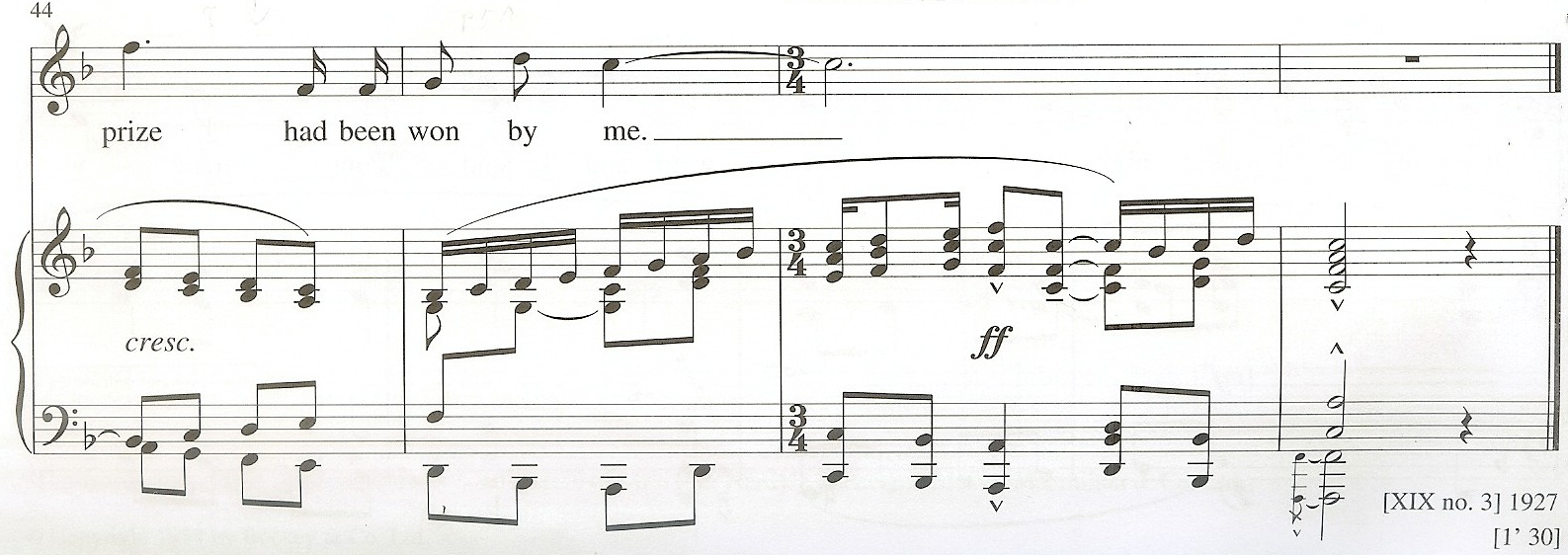
For additional comments about the form as well as a table outlining the structure of the song please refer to: Structure - Van der Watt. Mark Carlisle has also included some comments in his dissertation, to view them please refer to: Form - Carlisle.
Rhythm: The most prominent rhythmic feature in the song, a rhythmic motif was mentioned above in the Form category. The rhythmic figure is found in the accompaniment as well as the vocal line throughout the song (see example below).
First occurrence of rhythmic motif in measure 3. (Finzi, 92)

Within the piano accompaniment it can be found in measures 3, 8, 22, 26, 27, and 35. In the vocal line it is found in measures 13, 19, 21, 27, 34, 37, and 39. Sometimes there is a slight variation to the end of the motif but it is still discernible (see example below).
Variation of rhythmic motif in measure 37. (Finzi, 94)

Another interesting use of rhythm can be found in the piano accompaniment. The rhythmic activity in the piano accompaniment can be divided into three sections, the beginning is very stagnant as it supports the vocal line in a recitative manner then in measure twenty-two there is more rhythmic activity and then in measure thirty-seven the activity accelerates to the end (see examples below).
Stagnant rhythmic activity at the beginning of the song in measures 11-2. (Finzi, 92)
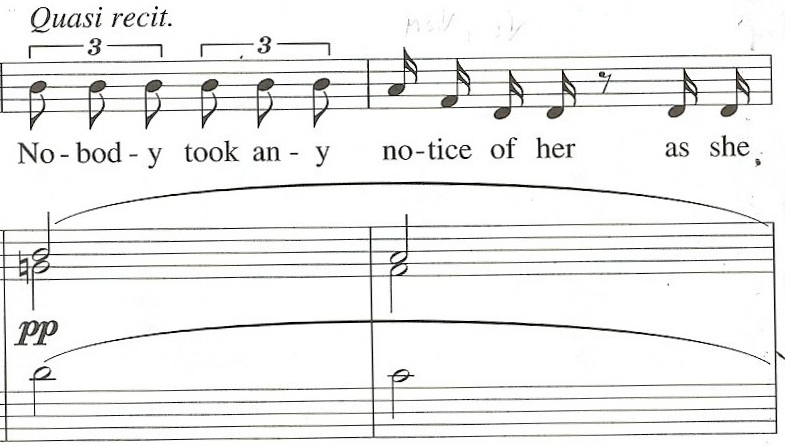
Moderate rhythmic activity in measures 22-5. (Finzi, 93)


Accelerated rhythmic activity in measures 37-9. (Finzi, 94)

There is greater use of sixteenth notes in the vocal line than most of Finzi's songs and this offers a nice balance to the less active piano accompaniment at the beginning of the song. The text setting is very good and often times it shows how careful Finzi was to set the text idiomatically with short syllables receiving short rhythmic durations and longer syllables receiving longer note values (see example below).
Text setting in measures 14-6. (Finzi, 92)

Text setting in measure 18-9. (Finzi, 92)

Text setting in measure 32-3. (Finzi, 93-4)

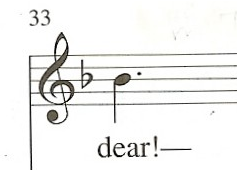
For additional information about the use of rhythm and the rhythmic motifs within the song please refer to: Rhythm - Van der Watt.
A rhythmic duration analysis was performed and for the results please refer to: Rhythm Analysis. Information contained within the analysis includes: the number of occurrences a specific rhythmic duration was used; the phrase in which it occurred; the total number of occurrences in the entire song.
Melody: One of the most prominent melodic features of the song is a melodic fragment that is repeated several times and is particularly wed to a rhythmic figure that occurs more often than the melodic fragment. The melodic fragment can be found in measures three, and eight in the piano and thirteen and twenty-one in the vocal line (see examples below).
Melodic figure in measure 3 and 8 in the piano accompaniment. (Finzi, 92)


Melodic figure in measures 13 and 21 in the vocal line. (Finzi, 92-3)
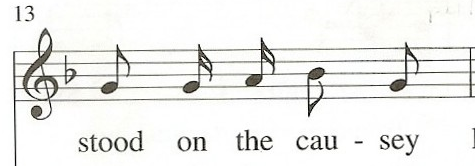

Another prominent feature of the song is actually the lack of melodic material particularly in the vocal line. This is possibly due to the vocal line resembling a recitative passage and more specifically, numerous occurrences of unison pitches. There are twenty-eight unison pitches in the first twenty-one measures. Finzi hasn't abandoned his normal practices totally, he still utilizes step-wise motion and small leaps for the vocal line and beyond measure twenty-one the song looks more like Finzi's standard fare. The largest leaps are reserved for the second stanza in the vocal line. They consist of two descending octaves, two descending minor sevenths, and a single ascending minor seventh. The interval of a minor 7th is rarely used by Finzi and in fact within this set, Till Earth Outwears,"At a Lunar Eclipse" is the only song a descending minor seventh occurs, and only once. The descending minor sevenths seem overshadowed by the descending octave leaps and even more so by the ascending minor seventh. Finzi writes the ascending minor seventh between measures forty-three and forty-four on the text "a prize." And, the "prize" seems especially jubilant because of the large leap (see example below).
Ascending minor seventh in measures 43-4. (Finzi, 94)
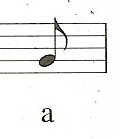
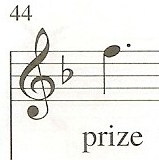
For additional information about the melodic material within the song please refer to: Melody - Van der Watt.
An interval analysis was performed for the purpose of discovering the number of occurrences specific intervals were used and also to see the similarities if there were any between stanzas. Only intervals larger than a major second were accounted for in the interval analysis. For a complete description of the results of the interval analysis please see the table at the bottom of the page or click on: Interval Analysis.
Texture: The texture is primarily homophonic. Mark Carlisle in his comments writes: "Although the texture remains predominately homophonic throughout, the growing independence of voices in the accompaniment that can be seen in measure 24-26, 33-34, and 36-37 provide for much more textural mobility than is heard in the opening measures of the piece. Even with the increased flexibility that begins in measure 22, however, the general 'weight' of the texture remains on the light side during the remainder of the song, with an emphasis on clarity rather than thickness and power." (Carlisle, 47-8) To view Dr. Carlisle's comments in total please refer to: Comments on the Music - Carlisle. Gerhardus Daniël Van der Watt writes: "The three- and four-part piano textures account for 72% of the bars. The two-part texture is only used in parts of the piano prelude and the climax of the song is supported with a five- to six-part texture in bar 40." (Van der Watt, 382)To view Dr. Van der Watt's full description about the texture including a table outlining the types of texture and the percentage in which they were used please refer to: Texture - Van der Watt.
Vocal Range: The vocal range spans an interval of a major thirteenth. The lowest pitch is the C below middle C and the highest pitch is the A above middle C.
Tessitura: The tessitura spans a perfect eleventh from the C below middle C to the F above middle C. A pitch analysis was performed for the purpose of accurately determining the tessitura and for the complete results please refer to: Pitch Analysis.
Dynamic Range: The dynamics span the distance from pianissimo to fortissimo. The first twenty-one measures of the song are at the piano or pianissimo dynamic after which the variety increases dramatically. The climax of the song for the vocal line occurs in measure forty on the word "all" but Finzi indicates a diminuendo one measure later in the piano part and by the end of measure forty-three his indication is for mezzo-piano which coincides with the text "a prize." Under the word "prize," Finzi calls for a crescendo and two measures later he indicates fortissimo making the end of the song the true climax. For additional comments about the dynamics including a table listing where each dynamic is indicated within each stanza please refer to: Dynamics - Van der Watt.
Accompaniment: The accompaniment begins very lightly and offers a simple support for the vocal line. Beginning in measure twenty-two the accompaniment becomes more active and by measure thirty-seven it is extremely active in comparison to the beginning. This increase in activity may catch one off-guard. For example, the numerous indications of changes in the dynamics grows exponentially after measure twenty-one and therefore ones full attention is required. At first glance the song may look fairly easy but it grows in complexity and should not be taken for granted. For additional information about the accompaniment please refer to: Accompaniment - Van der Watt.
Published comments about the music:
"In 1940 also Finzi revised his 1927 setting of Hardy's 'The market-girl', rewriting the middle. The song shows Finzi's parlando, conversational style at its best: the introduction so plaintive and bare; the piano bass octaves adding seriousness to 'sell . . . herself . . . too'; the ripple of movement at 'as I passed nigh'; the confiding tone at 'and so it began': here are tenderness, a humorous chuckle, and - unusually for Hardy and Finzi - a triumphant ending."
(McVeagh, 113)
Pedagogical Considerations for Voice Students and Instructors: The range is quite comfortable in this song for both the tenor in the high key and the baritone in the medium/low key. Measures thirty-six through the end of the song are possibly the most challenging with the climax for the vocal line in measure forty and the crescendo to the fortissimo dynamic while sustaining the text "me." If the high note in measure forty is difficult, observe where the breath is taken leading up to measure forty. It seems best to take a breath in measure thirty-eight before the text, "and." Another consideration for the high note is to monitor whether or not the line is being broken and another on-set is attempted for the text "all." Some students may attempt to insert a glottal on-set before the vowel or they may aspirate. A safer approach to the high note is to lightly connect the final [t] of "it" to the [a]. It should not become the word "tall" but rather a hint of [t] on the high note. As was mentioned earlier the dynamics in the final measures may present some difficulty for the voice. The mezzo-piano dynamic in the accompaniment is in contrast to the high note on the text "prize" and so it should not be sung softly. The final text, "me" requires a crescendo to match the piano accompaniment but one should be careful to not push the voice or to spread the [i] vowel.
Dr. Mark Carlisle records in his dissertation the following observations and advice: "This song, from the performers perspective, is one of this set's most accessible in both technical and interpretive requirements. The tessitura is relatively low, and although the range requires of the singer an a¹ in measure 40, there is little else that would cause any serious technical problem. The poetry is also quite easily understood, especially in comparison to many other Hardy poems, and should not create too many textual problems for either the performer or listener." (Carlisle, 49)
"Although this piece is less complex than many others by Finzi, it should not be assumed that it is necessarily appropriate for a first year voice student. On the contrary, even the most accessible of Finzi's songs generally require a higher level of musical and poetic awareness than can usually be found in a beginner. Nevertheless, unlike some of Finzi's songs on Hardy texts that demand the technical and interpretive skills of graduate-level singers, this one should certainly be considered as possible repertoire for undergraduate students. A third or fourth year tenor with solid interpretive skills should be quite capable of giving to an audience a very musical and artistic rendering of this song." (Carlisle, 50-1)
✦✼✦✼✦✼✦✼✦✼✦✼✦✼✦✼✦✼✦✼✦✼✦✼✦✼✦✼✦✼✦✼✦✼✦
Below one will find excerpts from unpublished dissertations. The excerpts should provide a more complete analysis of The Market-Girl for those wishing to see additional detail. Please click on the link or scroll down.
Gerhardus Daniël Van der Watt - The Songs of Gerald Finzi (1901-1956) To Poems by Thomas Hardy
✦✼✦✼✦✼✦✼✦✼✦✼✦✼✦✼✦✼✦✼✦✼✦✼✦✼✦✼✦✼✦✼✦✼✦
| Pitch Analysis | ||||
|---|---|---|---|---|
| pitch | stanza 1 |
stanza 2 |
total | |
highest |
A |
1 |
1 |
|
G |
0 |
|||
F |
2 |
5 |
7 |
|
E |
7 |
3 |
10 |
|
D |
8 |
7 |
15 |
|
middle C |
8 |
7 |
15 |
|
B |
13 |
9 |
22 |
|
A |
9 |
8 |
17 |
|
G |
8 |
9 |
17 |
|
F |
6 |
10 |
16 |
|
E |
3 |
2 |
5 |
|
D |
4 |
3 |
7 |
|
lowest |
C |
3 |
3 |
6 |
Audio Recordings
The Songs of Gerald Finzi to Words by Thomas Hardy
|
|
|
|
Gerald Finzi Song Collections |
|
|
|
The English Song Series - 16 |
|
|
|
Song Cycles for Tenor & Piano by Gerald Finzi |
|
|
|
Oh Fair to See: Songs by English composers |
|
|
|
Songs of the Heart: Song Cycles of Gerald Finzi |
|
|
|
Twenty-Four Aspects of an Amorous Nature |
|
|
|
The following is an analysis of The Market-Girl by Gerhardus Daniël Van der Watt. Dr. Van der Watt extended permission to post this excerpt from his dissertation on October 8th, 2010. His dissertation dated November 1996, is entitled:
The Songs of Gerald Finzi (1901-1956) To Poems by Thomas Hardy
This excerpt comes from Volume II and begins on page three hundred seventy-six and concludes on page three hundred eighty-three. To view the methodology used within Dr. Van der Watt's dissertation please refer to: Methodology - Van der Watt.
1. Poet
Specific background concerning poem:
"The poem comes form Time's Laughingstocks (1909) and is undated."
(Van der Watt, 376)
2. Poem
"In this minute, anecdotal poem the persona, presumably Hardy in habitual musing about all women he encounters tells the reader about a young girl, desperately trying to sell her wares at the roadside. The reader is told that she is not very successful and the persona suggests the passers-by are so indifferent to her that they would not take her goods even if she offered herself with them. In the second stanza the persona's true intentions slowly become evident: His observations of this girl are far more than casual and he initiates a conversation which leads to a relationship. The exact extent of this relationship, the persona leaves to the reader: "soon we knew what the end of it all must be". He nevertheless, rejoices in the unique 'catch' he has made."
(Van der Watt, 376)
"This little narrative poem is in the style of a pastoral love lyric."
(Van der Watt, 376)
"The poem consists of two unusually long-lined quatrains with a paired rhyme scheme: aabb ccdd. The textual metre is mainly dactylic, with a number of trochaic and iambic interpolations."
(Van der Watt, 376)
"The poem was almost certainly written tongue-in-cheek and with characteristic irony on Hardy's part. It is a well-known fact that Hardy had several affairs or rather attempted affairs before, during and after his two marriages (Tryphena Sparks, Eliza Nichols, Emma Gifford (first wife), Rosamund Thompson, Florence Henniker, Florence Dugdale (second wife), Gertrude Bugler and many more!). Martin Seymour-Smith writes in his biography, Hardy, about the 1890s:"
(Van der Watt, 376)
"It was at just this time that Tom's eye began to rove. Far too much has been made of this by prudes, hypocrites and over-solemn commentators: after all, it is the most natural thing in the world. But it cannot be ignored because of that. Eventually that excitable eye would fall upon Florence Henniker, who was to excite his lust and love - and finally, if only temporarily, a fierce involuntary resentment, which he would express in the story, An Imaginative Woman and less directly in Jude. Tom was able to acknowledge and deal with his feeling for Florence Henniker and, more efficiently for her predecessor, Rosamund Thompson - so there was no question of his being more adolescent than any other man; if anything he was less so." (Seymour-Smith, 403) (Van der Watt, 377) |
"The poem does not necessarily reflect autobiographic circumstances, but rather gives us insight into Hardy's natural inclination towards women and the ease with which he was attracted even to perfect strangers."
(Van der Watt, 377)
Setting
1. Timbre
VOICE TYPE/RANGE
"The song is set for tenor voice and the [range] is a perfect thirteenth from the first C below middle C."
(Van der Watt, 377)
"The piano accompaniment's highest pitch is the second A above middle C (b. 40), coinciding with the vocal climax on the word "all". The lowest pitch used in the piano part is the third F below middle C (b. 41 and 47). Other low pitches in the same vicinity occur in bars 19-22 and 40-47. In other than these sections, a middle sonority is used. There are no indications for the use of pedalling. There are, however, many legato indications which would require extensive, sensitive use of the pedal."
(Van der Watt, 377)
"Although the legato touch dominates in the accompaniment, there are a number of other indictions. A very unlikely staccato indication appears in bar 20 on a G octave in the right hand part. It is the only staccato indication in the song and is more likely a misprint than an actual indication. Portamento accents occur in bars 4, 9, 19, 33, 34, 36(2), 39(3) and 46. These have a similar function throughout, namely they accentuate individual pitches or melodic fragments. Two types of stronger accents are used and are concentrated towards the end of the song (b. 40-47). The first accent (>) occurs nine times in bars 40 - 41 with the vocal climax, "all must be", the second (^) occurs four times in bars 46 - 47 as part of the short but exuberant postlude."
(Van der Watt, 377)
"The atmosphere, mostly carried by the piano part, presents a gradual development from almost pathetic melancholy to joyous ecstasy. Bars 1 - 10, the prelude to the song, depict the miserable circumstances of the market girl: alone, possibly cold, dejected, yet full of expectation. In bars 11 - 26 the musical material projects the persona's sympathy towards her. In bar 27 - 36, the sympathy now turns into interest and even anticipation. The final section, with its sudden semi-quaver movement, gives rise to exuberance and finally ecstasy, "a prize had been won by me." It is clear that the composer planned this development of atmosphere carefully in conjunction with the text."
(Van der Watt, 377)
2. Duration
"The textual metre is mostly dactylic and is complemented by a simple duple time-signature (and not a triple time-signature, as might be expected with a dactylic textual metre). There is only one deviation from this time-signature, which occurs in bars 46 and 47. These bars are extended slightly to prolong the expression of ecstasy."
(Van der Watt, 377)
Rhythmic motifs
"A motif consisting of a quaver, two semi-quavers and two quavers (motif 1), occurs 16 times in both piano and vocal parts (b. 3, 8, 13, 21, 22, 23(varied), 27(2), 31(varied), 34, 35, 37(varied), 39(varied), 40, and 41), throughout the song and has a strong unifying role. The roots of motif 1 lie in the text, "stood on the causey kerb" (b. 13), but this is anticipated in the piano part twice (b. 3 and 8) and also has a melodic component. Motif 2, consisting of two crotchets, occurs 22 times between bars 15 and 37. This motif is of a more general nature and carries the main metric movement in the particular section. The motif consisting of four quavers (motif 3) also occurs 17 times exclusively in the latter half of the song (b. 23-45) and is indicative of the growing excitement that develops in this section. Motif 4, consisting of two minims, is localized to the opening section of the song (b. 1-21) and characterizes the slower metric and rhythmic movement associated with the more melancholic mood. The rhythmic material of the vocal part, typical of the recitativo-style (Quasi recit. b. 11), follows the natural speech rhythm fairly closely. With the piu cantando indication (b. 22), the rhythmic material does not do less justice to the speech rhythm. The intention here is that a smoother legato singing-style be achieved in the latter half of the song."
(Van der Watt, 378)
Rhythmic activity vs. Rhythmic stagnation
"The rhythmic activity, as has been hinted at in the previous section, follows the developing atmosphere in the song. One has to differentiate between the vocal part and the piano part in this case due to the vocal part's recitativo-style which makes it rhythmically quite active. In contrast, the piano part as main carrier of the atmosphere is initially stagnant, moving mostly in minims (b. 1-13). The next section has a crotchet movement as basic movement (b. 14-21). From bars 22-36 the tempo increases (b. 22 Poco animato [quarter note equals] c. 76) and the rhythmic movement doubles again to a quaver. Finally, a semi-quaver movement all but takes over in the last section of the song (b. 37-47). The gradual increase in rhythmic activity supports other elements in the establishment of a subtly changing atmosphere."
(Van der Watt, 378)
Rhythmically perceptive, erroneous and interesting settings
"The following words have been set to music perceptively:"
 (Van der Watt, 378)
(Van der Watt, 378)
Lengthening of voice consonants
"The following words containing voiced consonants have been rhythmically prolonged in order to make the word more singable:"

(Van der Watt, 378)
"The tempo indication is Tempo commodo [quarter note equals] c. 72. Tempo deviations are listed below:"
Bar no. |
Deviation |
Bar no. |
Return |
Suggested reason/s |
22 |
Poco animato [quarter note equals] c. 72 |
- |
- |
New atmosphere is initiated |
25 |
pochiss. ritardando |
27 |
a tempo |
End of stanza 1, opening of stanza 2 is indicated |
31 |
retenuto |
37 |
a tempo |
text supported - sympathetic: "Poor maidy dear" |
40 |
poco allarg. |
42 |
a tempo |
Climactic text emphasized: "all must be" |
3. Pitch
Intervals: Distance distribution
Interval |
Upwards |
Downwards |
Unison |
(43) |
|
Second |
28 |
27 |
Third |
1 |
10 |
Fourth |
8 |
2 |
Fifth |
4 |
2 |
Sixth |
3 |
0 |
Seventh |
1 |
2 |
Octave |
0 |
2 |
"There are 43 repeated pitches (or 32% of the total number), 45 rising intervals (or 345) and 45 falling intervals (or 34%). The smaller intervals (a third and smaller) account for 109 intervals (82% of the total number) while the larger intervals (fourths and larger) account for 24 (or 18%). The use of vocal intervals is therefore very sympathetic to the voice. There is a particularly high incidence of repeated pitches, relating to the fact that some 11 bars are in a recitativo-style. There are a number of specific setting requiring comment."
(Van der Watt, 379)
Interval |
Bar no. |
Word/s |
Reason/s |
3rd down 3rd down |
12 |
notice of |
Reinforce emotional content |
5th up |
17-8 |
garden herb |
Emphasis |
3rd down 3rd down |
20 |
give her wares |
Reinforce emotional content |
5th up |
21-2 |
that day |
Emphasis |
4th up |
24-5 |
a bargain |
Reinforce meaning |
5th down |
26 |
way But |
Change of register |
4th down |
29 |
passed nigh |
Reinforce meaning |
6th up |
30-1 |
I went |
Emphasis |
5th down 4th up |
32-3 |
maidy dear |
Reinforce emotional content |
7th down |
33 |
dear and |
Change of register |
6th up |
33-4 |
will none |
Emphasis |
6th up |
37 |
began |
Emphasis, emotional content - excitement |
5th up 8th down |
39-40 |
it all must |
Emphasis, reinforce emotional content |
7th down |
41 |
be And |
Change of register |
7th up |
43-4 |
a prize |
Emphasis, emotional content - excitement |
5th up |
45 |
won by |
Emphasis, emotional content - excitement |
Melodic curve
"A melodic curve of the vocal line is represented below. Specific words are indicated to show the relationship between the melodic curve and the meaning:"
 (Van der Watt, 380)
(Van der Watt, 380)
Climaxes
"The song has a single vocal climax in bar 40 on the second A above middle C. This climax, conveniently, occurs on the word "all" in the line: "and soon we knew what the end of it all must be". The climax is supported texturally (five seven-part chords), dynamically (f and accents - >) and by the use of a broader tempo (poco allarg.)."
(Van der Watt, 380)
Phrase lengths
"Only two rests are used in the vocal part (b. 12² and 36¹-²) and as a result, phrases, from a vocal point of view, are long. Some suggestions for places for breathing are given below:
Stanza 1 |
Bars 14², 18², 22², and 26² |
|
Stanza 2 |
Bars 30², 33², 38¹, 41², and 43² |
"The key-signature of B flat, refers in this song, to 'flat' orientated tonal use and the eventual outcome of the tonal meandering, namely F major. The song opens in g minor, that is, in a Dorian relation to the B flat key-signature, and turns in B flat and E flat majors before it stabilizes in F major in bar 29. All modulations are summarized below:"
Modulation
Bar no. |
From - To |
Suggested reason/s |
1 |
g min |
Interlude - melancholy atmosphere |
11 |
g - B flat |
Stanza 1 - more sympathetic atmosphere |
16 |
B flat - E flat |
Same atmosphere retained |
22 |
E flat - B flat |
More positive attitude, suppressed excitement |
29 |
B flat - F |
New atmosphere, excitement, exuberance is set |
"There are 19 bars in F major, making it the most prominent key and consequently it carries the most prevailing atmosphere. It is clear from the summary the tonal structure was carefully planned to achieve a gradual development from plaintiveness to ecstasy."
(Van der Watt, 380)
Chromaticism
"There are some chromatic alterations though it is not always clear what is meant to be chromatic and what is part of a swiftly changing key. The G flat and D flat in the g minor context in bar 9 is certainly intentional chromaticism. At the final chord of the prelude, a sense of expectation is created as if the market girl expects someone to buy, yet it does not happen. The occurrence of an A flat is mostly explainable in E flat major and therefore does not have a true chromatic function."
(Van der Watt, 381)
HARMONY AND COUNTERPOINT
"A significant number of extended triads are used in the piano part: (b. 15²(IV⁹), 24¹(ii⁶₅), 24²(iii⁷), 25²(ii⁹), 27¹(IV⁷), 29²(ii⁴₂), 31¹(IV⁶₅), 31²(ii⁹), 39¹(IV⁷), 40²(IV⁴₃) and 45¹(ii⁴₃)). These chord extensions are at the heart of Finzi's expressive style. There is furthermore a strong tendency to use first and second inversion chords: between bar 39 and 46 there is virtually no chord in root position."
(Van der Watt, 381)
Non-harmonic tones
"Non-harmonic tones play a less prominent role in the song and are part of the composer's general compositional procedures."
(Van der Watt, 381)
Harmonic devices
"Two fairly long pedal notes occur in the prelude (b. 3-6(B flat), b. 8-10(E flat)) as part of the setting of the initial melancholic atmosphere."
(Van der Watt, 381)
Counterpoint
"Apart from the general use of two and three-part counterpoint, especially from bar 22 onwards, small imitations occur between the vocal and piano parts (b. 21 voice - b. 22 piano and b. 34 voice - b. 35 piano) and in the piano part internally (b. 26-27, 38(sopr.) - 39¹(alto) - 39²(sopr.)). These minute imitations help to create a sense of unity in the song."
(Van der Watt, 381)
"Loudness variation is given in the following summary:"
 (Van der Watt, 381)
(Van der Watt, 381)
FREQUENCY
"There are 29 indications in the 49 bars which means that dynamic indications have been used sparingly. There are no separate indications for the voice, which implies that the voice should follow the indications given in the piano part."
(Van der Watt, 381)
RANGE
"The lowest level indication, pp (b. 11), presumably lasts until bar 22 (cresc.) which includes virtually the entire first stanza. This level coincides with the sympathetic atmosphere created in the first stanza. The loudest level indication occurs in the penultimate bar (b. 46) as the pianistic outcome of the exuberance and ecstasy suggested by the preceding text: "a prize had been won by me."
(Van der Watt, 381-2)
VARIETY
"The indications used are:"

(Van der Watt, 382)
DYNAMIC ACCENTS
"Portamento accents are used mildly to accentuate certain notes or melodic fragments (b. 4, 9, 19, 33-4, 36, 39, 46). Stronger accents are used in bars 40 (>), 46-7(^) and coincide with the climax of the song."
(Van der Watt, 382)
"The density varies loosely between two and eight parts including both piano and voice. It is significant to note that the very first bar consists of a two-part piano chord while the final bar consists of an eight-part piano chord. The discrepancy provides the outline of what happens in the song texturally and tallies with the procedure followed with the other elements of music where a gradual development of atmosphere is created. The thickness of the piano part is represented in the following table:"
No. of parts |
No. of bars |
Percentage |
2 parts |
4 |
9 |
3 parts |
23 |
49 |
4 parts |
11 |
23 |
5 parts |
7 |
15 |
6 parts |
1 |
2 |
8 parts |
1 |
2 |
"The three- and four-part piano textures account for 72% of the bars. The two-part texture is only used in parts of the piano prelude and the climax of the song is supported with a five- to six-part texture in bar 40."
(Van der Watt, 382)
"The structure of the song is represented in the following table:"
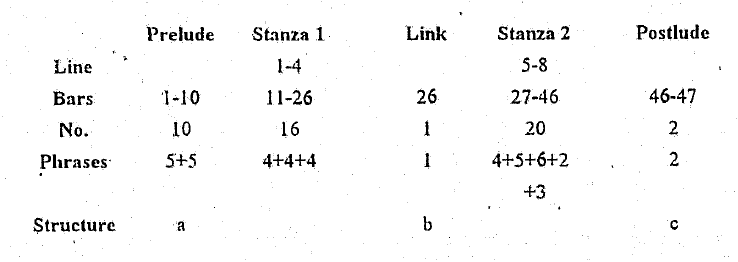
"As far as material is concerned, the song has a through-composed structure, a single rhythmic motif (a quaver, two semi-quavers and two quavers) largely retaining the unity. The recitativo section (up to bar 22) and piu contando section which follows suggests that the structure could be that of recitativo and arioso, in which case the song as a whole may be seen to have a binary structure (b. 1-22(A) - 22-47(B))."
(Van der Watt, 382-3)
7. Mood and atmosphere
"Much has already been said about the creation of atmosphere in the song. A summary, here, will suffice:"
Prelude |
A bleak, almost pathetic mood is set which portrays the market girl's desperation and loneliness |
|
Stanza 1 |
The persona's sympathetic, slightly condescending attitude is portrayed |
|
Stanza 2 |
A greater sense of interest, anticipation makes way for feelings of ecstatic joy in the final moments |
"The treatment of the atmosphere is organic: it grows with the story line and emotional undercurrent of the text.
(Van der Watt, 383)
General comment on style
"The parlando vocal style of the song is most sympathetic to the voice (82% smaller intervals). There are, however, a number of larger intervals used, particularly sevenths. The texture, dynamics, tempo, rhythmic movement and harmonic material all work together to create an effective, gradual development of the atmosphere in the song; a remarkable painting of atmosphere."
(Van der Watt, 383)
Unpublished Analysis Excerpts
The following is an analysis of The Market-Girl by Mark Carlisle. Dr. Carlisle extended permission to post this excerpt from his dissertation on September 7th, 2010. His dissertation dated December 1991, is entitled:
Gerald Finzi: A Performance Analysis of A Young Man's Exhortation and Till Earth Outwears, Two Works for High Voice and Piano to Poems by Thomas Hardy
This excerpt begins on page forty-four and concludes on page fifty-one of the dissertation.
Comments on the Poem
""The Market-Girl" is the fourth of Hardy's A Set of Country Songs. It was first published in 1903 in a literary and artistic annual called The Venture, but it is unknown when it was actually written. (Bailey, 225-6) The location of the setting is perhaps the corner of South Street and High West in Dorchester. Farmers still bring produce to this corner for sale, which in Hardy's time was bounded by a "causey kerb," or causeway curb."
(Carlisle, 44)
"This poem is a narrative that is certainly one of Hardy's most accessible. It describes a meeting between a young market girl attempting to sell her wares, and the poet who sees that prospective buyers are passing her by with little thought for what she has to offer. It is neither a complex nor profound poem, but simply and briefly relates the events that lead to a wonderful relationship. The poet, seeing that the market-girl is having no success at selling her products, strikes up a casual conversation with the words, "Poor maidy dear! and will none of the people buy?" He does so presumably out of a sense of compassionate pity, but in time finds that, although no one else took an interest, it is he who has "won the prize."
(Carlisle, 44-5)
"The song opens with a textural, harmonic, and melodic sparseness that musically depicts the isolation and solitude that surrounds the market-girl, even as people can be found around her. Measures 1-10 are a prelude that introduces the main theme of the first stanza as well as a rhythmic motive of sixteenth-note, eighth-note patterns that suggest an occasional passer-by who continues on without stopping. The textural structure of this opening section, with at most only one half-note chord per measure (measures 4-5 and 9-10 are tied half-note chords), creates a slow harmonic rhythm in 2/4 meter. The use of minor instead of major keys at the beginning also adds much poignancy to the measures that precede the loneliness of the opening words, 'Nobody took any notice of her.'"
(Carlisle, 45)
"The short rhythmical motive previously mentioned is woven throughout the song in both accompaniment and vocal lines. It is heard not only in this exact rhythmical configuration, but also in many variations as well. Examples can be seen in measure 13, 19, 21, and 27 of the vocal line, and measures 22, 26, 27, and 35 of the accompaniment. The consistent use of this motive provides the primary means of unity in this song, along with the help of a rather stable textural structure, both of which are needed to offset the diversity found in the elements of the form and harmony (see Example 3)."
(Carlisle, 45-6)
"The song is through-composed, with new music provided for all of the poetic text, and even musical sectionalization corresponding to poetic 'thought' sectionalization is difficult to delineate. The text of the song actually starts in measure 11, under the musical direction of Quasi recitativo provided by Finzi, and is supported by music that retains the thin texture and slow harmonic rhythm of the opening measures. The melody, perhaps even more than in most of Finzi's songs, follows closely the rhythmical inflection of the words. In fact, one can easily see in much of this piece the influence of musical style of some of England's earlier song-writers such as Dowland and Purcell."
(Carlisle, 46)
"Example 3. 'The Market-Girl,' measures 1-19." (Carlisle, 46) |
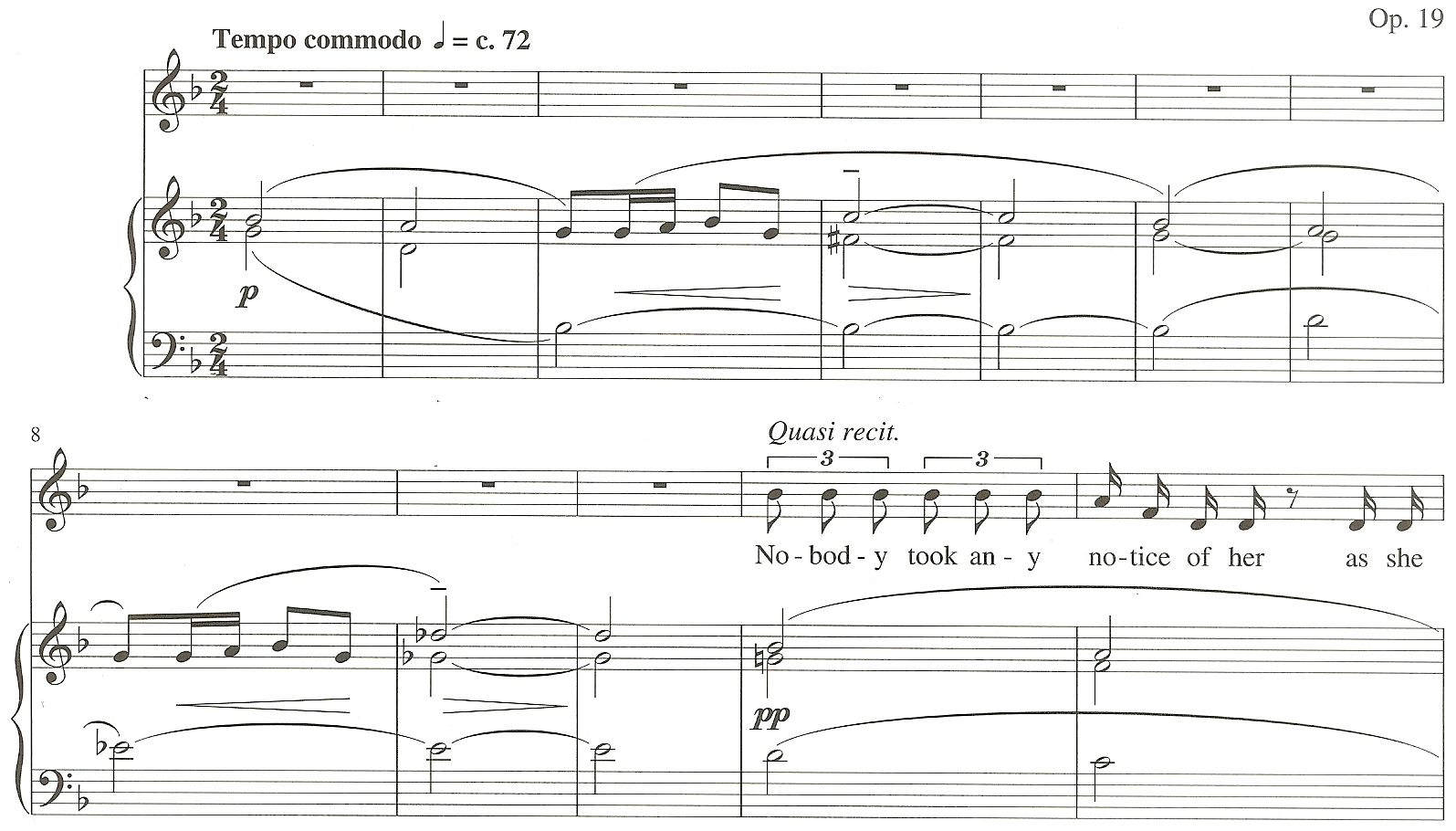


"The accompaniment as a means of musical expression is clearly subservient to the melody much of the time, providing basically harmonic support for the delivery of the poetic text. It is primarily in the use of contemporary harmonies and more diversity of textures that substantive differences can be seen and heard."
(Carlisle, 47)
"The first concrete textural change occurs in measure 22, although the change is more of textural flexibility than thickness. Measures 3 and 8 notwithstanding, the texture of the accompaniment prior to this moment is almost entirely chordal, much in the style of a church hymn. However, beginning in measure 22, the accompaniment assumes greater independence through the use of moving eighth-note chords that contain much more rhythmical interest. Although the texture remains predominately homophonic throughout, the growing independence of voices in the accompaniment that can be seen in measure 24-26, 33-34, and 36-37 provide for much more textural mobility than is heard in the opening measures of the piece. Even with the increased flexibility that begins in measure 22, however, the general 'weight' of the texture remains on the light side during the remainder of the song, with an emphasis on clarity rather than thickness and power."
(Carlisle, 47-8)
"The overall harmonic structure of the piece is also of a very flexible nature, as rarely is any single key defined well enough to be recognized as the predominate key of the song. This harmonic instability corresponds well to the emotional uncertainty of the poet as he attempts to comfort the young market-girl. Although the key signature indicates either F major or D minor, the opening eleven measures revolve more around G minor than in either of these keys. This is seen most clearly in measures 1-6, in which can be seen two sets of I-V-I relationships; one without the leading-tone F sharp in measure 2, and one with, in measures 4-5."
(Carlisle, 48)
"Specific key relationships become much less clear after measure 12, particularly through the use of chords built upon E flat and A flat, the lack of a consistent leading-tone, and the extensive use of non-chord tones. Chords built upon E flat and A flat represent Neapolitan chords in the keys of D minor and G minor respectively, yet neither of these two keys is ever established beyond the first eleven measures. Instead, the harmony gravitates toward F minor before establishing the parallel key of F major in measure 35-35, when a clear IV-V harmonic progression in the key of F major is heard. This defining of F major corresponds to the beginning of the last section of the poem, setting the stage for a suitably uplifting conclusion to the song with the words, 'And I found that though no others had bid, a prize had been won by me.' " (Carlisle, 48-9)
"This song, from the performers perspective, is one of this set's most accessible in both technical and interpretive requirements. The tessitura is relatively low, and although the range requires of the singer an a¹ in measure 40, there is little else that would cause any serious technical problem. The poetry is also quite easily understood, especially in comparison to many other Hardy poems, and should not create too many textual problems for either the performer or listener." (Carlisle, 49)
"Dynamic markings in the song are relatively few, and all are located in the accompaniment. Most seem dramatically appropriate and easily accomplished by the singer, although it might be suggested that the singer begin the song in measure 11 with a slightly higher dynamic level that pianissimo, as well as using a higher dynamic level in measure 44 at the word "prize." The opening text does require that the singer imply a certain feeling of sorrow and compassion, but this can more easily be handled by the energy of proper textual inflection rather than such a low level of dynamic energy to begin the song. Also, the poetic phrase, "a prize had been won by me" is of such a positive nature that it seems appropriate to vocally end the song with healthy, forte singing." (Carlisle, 49-50)
"Expressive markings for tempi are relatively few and far between in measures 1-21, but expand in number during the remaining measures. All make excellent musical sense and should be closely followed by both singer and accompanist. The opening marking of [quarter note] = c. 72 (Tempo commodo) is very good, but the singer should take special care not to "square" the tempo during the first few measures. Finzi has indicated a Quasi recitativo style for the entrance of the vocal line, and while some semblance of a regular tempo should still be maintained, flexibility is most certainly a necessity. It is also suggested that, in addition to those expressive markings that already exist, a poco ritardando be supplied by both musicians in measures 44-45 to give the closing text even more emphasis." (Carlisle, 50)
"Although this piece is less complex than many others by Finzi, it should not be assumed that it is necessarily appropriate for a first year voice student. On the contrary, even the most accessible of Finzi's songs generally require a higher level of musical and poetic awareness than can usually be found in a beginner. Nevertheless, unlike some of Finzi's songs on Hardy texts that demand the technical and interpretive skills of graduate-level singers, this one should certainly be considered as possible repertoire for undergraduate students. A third or fourth year tenor with solid interpretive skills should be quite capable of giving to an audience a very musical and artistic rendering of this song." (Carlisle, 50-1)
Unpublished Analysis Excerpts
The following is an analysis of The Market-Girl by Leslie Alan Denning. Dr. Denning extended permission to post this excerpt from his dissertation on September 8th, 2010. His dissertation dated May 1995, is entitled:
A Discussion and Analysis of Songs for the Tenor Voice Composed by Gerald Finzi with Texts by Thomas Hardy
This excerpt begins on page seventy-nine and concludes on page eighty of the dissertation.
"Though not without merit, 'The Market Girl' is most certainly one of those songs Finzi feared being overlooked if left without the support of a surrounding cycle of songs. Hardy's poem was published among his collection Time's Laughingstocks as the fourth in a set of seven poems titled 'At Casterbridge Fair,' Casterbridge being Hardy's fictitious name for present-day Dorchester. Finzi's conservatism and commitment to speech-like nuances are qualities which generally make his settings of Hardy desirable. However, these very qualities seem to bog down 'The Market Girl.'"
(Denning, 79)
"Hardy's simple poem describes an unnoticed market girl who doesn't seem to be able to even give her wares away. Though she is overlooked by many, we are led to believe that the speaker of Hardy's poem befriends her and eventually wins her heart. Finzi's setting is charming and owes everything to his parlando style. The song opens in a minor key and describes the girl in a tender sympathetic fashion. The voice line here is quasi-recitative supported only by a chordal accompaniment (musical Example 21)."
(Denning, 79)
"Example 21: The Market Girl, Measures 11-14." (Denning, 79) |
![]()
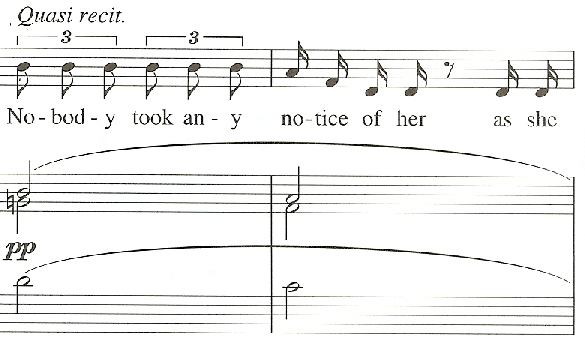
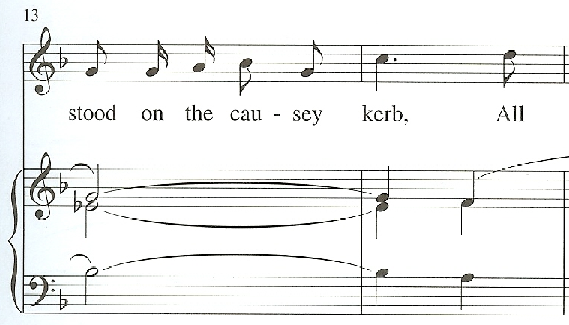
"As the young man notices her and eventually claims her as his prize, the accompaniment becomes a bit more animated and ends triumphantly in F-major."
(Denning, 80)
"It would be best to approach Finzi's grim opening lightly with the thrill of meeting the market girl's gaze already in mind. If not carefully approached, the market girl can appear quite hopeless and listeners might question her appeal. Finzi's performance directions are adequate except perhaps for the ritenuto in measure thirty-one. It is quite effective to actually lift there to separate the character's quoted line. It is also appealing to linger slightly on the triplet figures which appear throughout the vocal line. One last direction would be to thoroughly enjoy the triumphal ending, perhaps even taking extra time."
(Denning, 80)
"In this setting it seems Finzi could have profited from a more folk-like lyric approach, perhaps utilizing a more flowing melody or dance-influenced rhythms for a more spontaneous immediate appeal and better overall sense of the text."
(Denning, 80)

